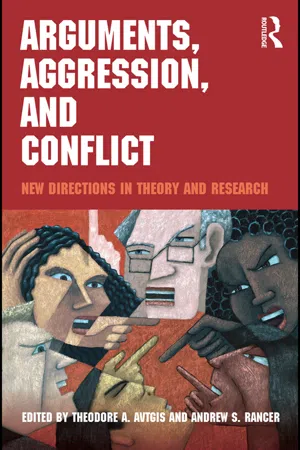
Arguments, Aggression, and Conflict
New Directions in Theory and Research
- 448 pages
- English
- ePUB (mobile friendly)
- Available on iOS & Android
Arguments, Aggression, and Conflict
New Directions in Theory and Research
About This Book
Arguments, Aggression, and Conflict provides a thorough examination of argumentative and aggressive communication. Editors Theodore A. Avtgis and Andrew S. Rancer bring together a score of prolific and informed authors to discuss aspects of the conceptualization and measurement of aggressive communication. The book features an exclusive focus on two "aggressive communication" traits: argumentativeness and verbal aggressiveness, one of the most dominant areas of communication research over the last twenty five years both nationally and internationally. The chapters include cutting-edge issues in the field and present new ideas for future research.
This book is a valuable resource for instructors, researchers, scholars, theorists, and graduate students in communication studies and social psychology. Covering a variety of topics, from the broad-based (e.g. new directions in aggressive communication in the organizational context) to the more specific (e.g. verbal aggression in sports), this text presents a comprehensive compilation of essays on aggressive communication and conflict.
Frequently asked questions
Information
Chapter 1
Verbal Aggressiveness as an Expression of Selected Biological Influences
Conceptual Orientation
A Scientific Perspective
Trait Verbal Aggressiveness and Acts of Verbal Aggression
Primacy of Biological Factors as Exogenous Variables
Interpersonal Efficiency and Strategic Aggression
Biological Factors Exogenous to Verbal Aggression
Genetic Inheritance
Table of contents
- Contents
- Preface
- Contributors
- Section I Conceptualization and Operationalization of Argumentative and Aggressive Communication
- Chapter 1 Verbal Aggressiveness as an Expression of Selected Biological Influences
- Chapter 2 Verbal Aggression and Prefrontal Cortex Asymmetry
- Chapter 3 Aggressive Communication
- Chapter 4 Measuring Argumentativeness and Verbal Aggressiveness
- Chapter 5 Exploring Constructive Aggressive Communication in China
- Chapter 6 Culture and Aggressive Communication
- Chapter 7 Global Communicator
- Section II Contextual Research on Argumentative, Aggressive, and Conflict Communication
- Section III Factors Influencing Arguments, Aggression, and Conflict Communication
- Index